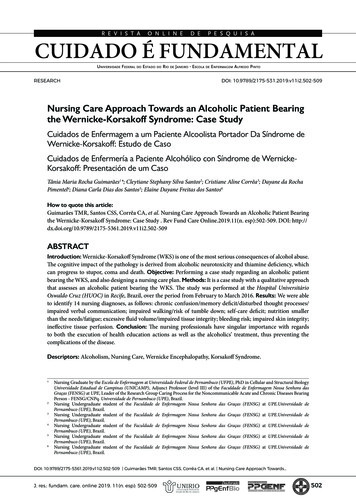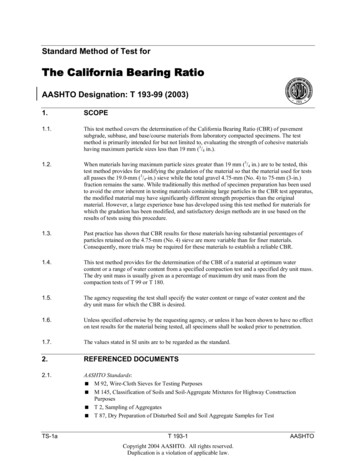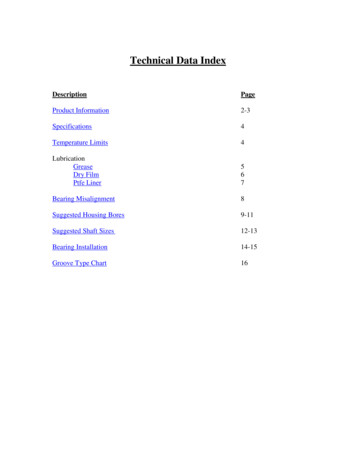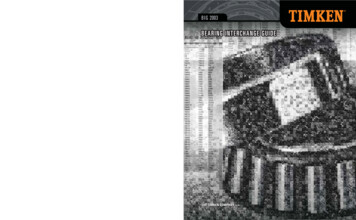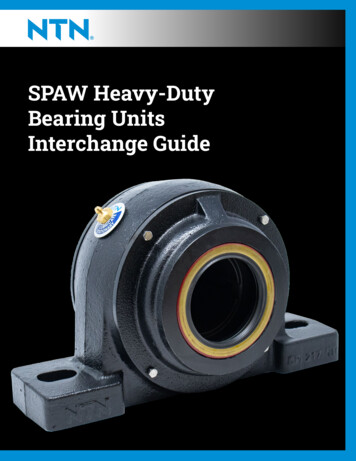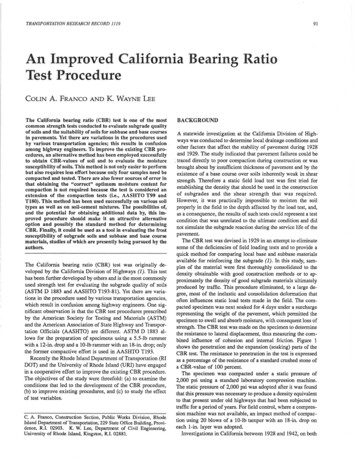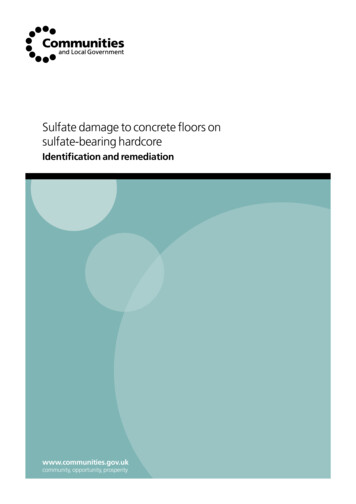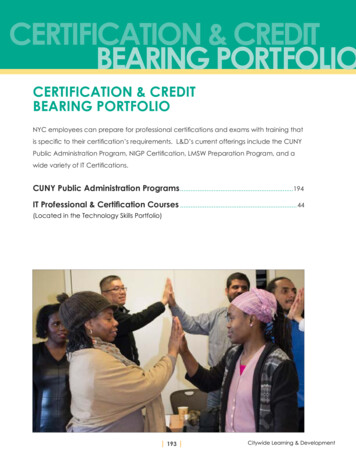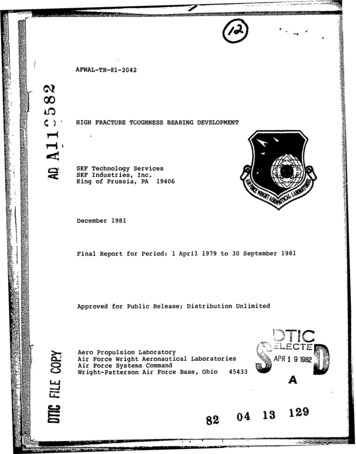
Transcription
AFWAL-TR-81-2042C )HIGH FRACTURE TOUGHNESS BEARING DEVELOPMENTSKF Industries, Inc.King of Prussia, PA19406December 1981Final Report for Period: 1 April 1979 to 30 September 1981Approved for Public Release; Distribution Unlimited-Aero Propulsion LaboratoryC.)S82Air Force Wright Aeronautical LaboratoriesAir Force systems Command45433Wright-Patterson Air Force Base, Ohio04APR 1 9 1982A13129
,ANOTICEWhen GovernmenL drawings,specifications.used for any purpose other than incr other data are connection with a definitely : related Government procurement operation, the United States Government thereby incurs no responsibility nor any obligation whatsoever; and the fact that the Government may have formulated,furnished, or in any way supplied the said drawing , specifications,or other data, is not to be regarded by implication or otherwise asinany manner licensing the holder or any other person or corpo-ration, or conveying any rights or permission to manufacture, use,or sell any patented invention that may in any way be relatedthereto.'-This report has been reviewed by the Office of Public Affairs(ASD/PA) and is releasable to the National Technical InformationService (NTIS).At NTIS, it will be available to the general public,including foreign nations.*This technical report has been reviewed and is approved forpublication.J ES F. DILLP oject EngineerHOWAJONS2Chief, Lubrication BranchFOR THE COMMANDERi4Chief, Fuels and Lubrication Division"If your address has changed, if you wish to be removed from ourmailing list,or if the addressee is no longer employed by yourorganization, please notify AFWAL/POSL, W-PAFB, Ohio 45433 to helpus maintain a current mailing list".Copies of this report should not be returned unless return isrequired by security considerations, contractural obligations, ornotice on a specific document.AIR FORCE/56780/31 March 1912- 100'-
DEPARTMENT OF THE AIR FORCEAIR FORCE WRIGHT AERONAUTICAL LABORATORMES (AFSC)WRIGHT-PATTERSON AIR FORCE BASE, OHIO 45433AT O.OAFWAL/POSL (J. F. Dill/54347)14 April 1982 AFWAL-TR-81-2042*TOAFWAL/TST (Stinfo)Attn: Alsenia McFarlane1. I have reviewed the drawings on Pages 6 and 8 of this reportwiththe contractor SKF who wrote the report and found that the inclusionof the proprietary notice was atioversight on their part.The contractor and this office request that that statement be eliminatedinany further reproduction of this report.2. If you have any further questions on this subject, pleasecontactme at the above extension.SF. DILLFJIAk-ubricat ion BranchFuels & Lubrication DivisionAerc Propulsion LaboratoryIIIOWN
SECURITY CLASSIFICATION OTHIS PAGE (U.n Date Entered.REPORT DOCUMENTATION PAGEREAD INSTRUCTIONSBBEFORE COMPLETING FORMI. REPORT NUMBER2. 3oVACCESSION NO3.RECIPIENT'S CATALOG NUMBERS.TYPE OF REPORT A PERIOD COVEREDAFWAL-TR-81-2042TITLE (-.,4 Subtitle)4.Final Re ort1 April 979 - 30 Sept.HIGH FRACTURE TOUGHNESS BEARINGDEVELOPMENT6.7.AUTHOR(s)9.ZONTRACT OR GRANT NUMUER(e)F33615-79-C-2007PERFORMiNG ORGANIZATION NAME AND ADDRESSSKF Industries,1.Inc .PROGRAM ELEMENT, PROJECT. TASKAREA & WORK UNIT NUMBERS3048 06 071100 First AvenueKing of Prussia, PA 19406It.AT81DO1 60.Maurer, R. E.Ninos, N. J.1981PERFORMING ORG. REPORT NUMBERCONTROLLING OFFICE NAME AND ADDRESS12.Aero Propulsion Laboratory (AFWAL/POSL)Air Force Wright Aeronautical LaboratoriesAir Force Systems Command45433Wright-Patterson AFB, OHREPORT DATEDecember 1981N.MBER OF PAGES.6114. MONITORING AGENCY NAME & ADDRESS(II dillerent from Controlling Ollfce)15.SECURITY CLASS. (of thle report)Unclassified15s.16.DISTRIBUTION STATEMENT (of EReport)for public release;distribution unlimited.DISTRIFUT'ON STATEMCNT (of M'e &batact entered In Block 20. If different from Report)ISI. SUPPLEMENTARY NOTES19.S FracKEY WORDS (Continue on reverse olde It necessary mnd Identify by block number)VIM-VAR M50 SteelBearing RacesHigh Energy Beam Heat Treatmentcure Toughness20.Surface TransformationHardeningBearing Fatigue LifeABSTRACT (Continue on reverse atde tI noreeoery and identify by block number) The purpose of this program is to perform fatigue life tests tocompare the rolling contact performance of high energy beam surface hardened VIM-VAR M50 steel with conventionally throughhardened VIM-VAR M50 steel.Two groups of 6009 size ball bearings (manufactured under AirForce Contract F33615-78-C-5018) were provided for life testing;one group containing conventionally through hardened VIM-VAR M50DD IAN71473EDITION OF I NOV 65 IS OBSOLETESECURITY CLASSIFICATION OF THIS PAGE (When Dat& Enitred)
"SECURITY CLASSIFICATION OF!2"steel rings,THIS PAGE(ohidDnte Zater/)/the other group containinelectron beam.(EB)surfacehardened VIM-VAR M50 steel inner rin, and conventionally throughhardened VIM-VAR M50 steel outer ri gs.Each group consists oftwenty bearings.The/inner ringfor both groups were manufactured from a single\ he4zt of VIM-VAR M50 steel to eliminate possiblefatigue life diffe erce due to m/aterial factors.The outer ringsfor both groups we /emanufactt red from a second single heat ofVIM-VAR M50 s ese4i\Rolling co tatt fatigue life testitig was performed yielding L10-lives of -9'L-x-O revolutions for the conventionally throughhardened bearings, and 1l-5JiýlO --million revolutions for the bearing group containing the EB esrfa-ce hardened inner rings.Theselives are consistent withithe expected performance of VIM-VAR M50"steel asri.,dicat e-by comparison with the calculated adjustedrating L10 I of -- 2 -- lO6--revolut ions.4'4The surface hardened bearing rings represent the firstapplication of high energy beam heat treatment to high-speed-steelrolling bearing components.The very successful test resultsare significant in that tey 'demonstratethat the traditionallyhigh rolling contact fatigue' performance of M50 steel is preservedin a surface hardened ring while improved component toughness isprovided by the lower hardness subsurface material.41ccess--4t/0SECURITY CLASSIFICATION OF THIS PAGE(?7,en Data Entered)i
SSUMMRY,This Final Report is submitted in accordance with the requirements of Air Force Contract F33615-79-C-2007.5Thisreport coverswork performed during the period from 1 April 1979 through30 September 1981.The purpose of this program is to perform fatigue life teststo compare the rolling contact performance-Zhigh energy beamsurface hardened VIM-VAR M50 steel with conventionally throughhardened VIM-VAR M50 steel.Two groups of 6009 size ball bearings (manufactured underAir Force Contract F33615-79-C-5018) were provided for lifetesting; one group containing conventionally through hardenedSVIM-VAR(EB)M50 steel rings, the other group containing electron beamsurface hardened VIM-VAR M50 steel inner rings, and con-ventionally through hardened VIM-VAR M50 steel outer rings.group consists of twentv bearingsEachThe inner rings for bothgroups were manufacLured from a single heat of VIM-VAR M50 steelto eliminate possible fatigue life differences due to materialfactors.--AThe outer rings for both groups were manufactured froma second single heat of VIM-VAR M50 steel.2Rolling contactfatigue life testing of conventionallythrough hardened VIM-VAR M50 steel bearings was conducted toprovide a baseline against which the surface hardened M50 bearingperformance is compared.The through hardened inner ring LIlife obtained is 91 x 106 revolutions.iii"5'5';-',ir"ISiI50This life is consistent
A--"with the expected performance of VIM-VAR M50 steel, as indicatedby comparison with the calculated inner ring adjusted ratingLI0life of 62 x 106 revolutions.Early failures were experienced in the testing of the firstfew bearings containing surface hardened rings.Metallurgicalanalysis revealed the presence of series of micro-pits alignedin the cross-groove direction in the ball paths of both testedAand untested inner rings.The origin of these pits was tracedto a near surface microstructural alteration associated withexcessive surface temperature experienced during EB hardening.The pits were formed through interaction of this microstructuralalteration with the ball path grinding operation.These pitsrepresent a severe disruption of the integrity of the rollingcontact surface.The extremely early failures experienced areconsistent with their presence.The EB hardened inner rings were regr6und to remove thelife limiting surface condition and assembled into bearings.Rolling contact fatigue testing provided an impressive L10 lifeof 151 x 106 revolutions.These surface hardened bearing ringsrepresent the first application of high energy beam heat treatment to high-speed-steel rolling bearing components.The verysuccessful test results are significant in that they demonstratethat the traditionally high rolling contact fatigue performanceof M50 steel is preserved in a surface hardened ring, whileiv
II,'Iihardnessimproved component toughness is provided by the lowersubsurface material.IA1111'I!v
TABLE OF CONTENTSPAGEPREFACEIINTRODUCTION2TECHNICAL APPnJACH45PROCEDURAL DETAILSTASK I -FATIGUELIFE TESTING10,Test Equipment10*Endurance Test Procedure12-RADIAL EXPANSION TESTING13TASK II15RESULTSBEARING LIFE TESTS* Conventionally Through HardenedM50 Steel BaselineElectron Beam Surface HardenedM50 SteelRADIAL EXPANSION TESTS1515.DISCUSSION27FAILURE ANALYSIS * 27Through Hardened M50 SteelBaseline Bearings27Electron Beam Surface HardenedM50 Steel Bearings27Radial Expansion of FatigueTested Inner -RingsCONCLUDING 657APPENDIX B60vi
ILLUSTRATIONSS PAGE4,Figure 1Assembly Drawing for 6009 VCC - ThroughHardened M50 Steel Test Bearing6Figure 2Assembly Drawing for 6009 VCD - EBHardened M50 Steel Test Bearing8Figure 3R2 Type Bearing Test Machine11Figure 4Apparatus for Radial Expansion of BearingInner Rings14Figure 5Weibull Plots of Through Hardened and EBSurface Hardened M50 Steel Bearing Life Data20Figure 6Characteristic Fragmentary Fracture ofThrough Hardened M50 Steel Inner RingResulting from Radial Expansion.PrimaryFracture Through Spall at Arrow. (Bearing #105)23Fracture Surfaces of Radially ExpandedThrough Hardened M50 Steel Inner RingsShowing Fracture Initiation at Spall (4X)24Characteristic Fracture of EB SurfaceHardened M50 Steel Inner Ring Resultingfrom Radial Expansion25Fracture Surfaces of Radially ExpandedEB Surface Hardened M50 Steel Inner Rings26Microstructure of Conventionally ThroughHardened M50 Steel Bearings (Nital Etch)28SEM Micrograph Showing Cross-Groove andCircumferential Texturing, and SpallProduced After Five Hours of Testingin EB Hardened Inner Ring (Bearing #331-201)30SEM Micrographs Showing Cross-GrooveOrientation of Micro-Pits (Arrows) in BallPath of EB Hardened Inner Ring (Bearing #331-201, Five Hours on Test)31SEM Micrographs Showing Cross-GrooveOrientation of Micro-Pits in Ball Path ofEB Hardened Innter Ring (Bearing #331-202,Five Hours on Test)32"AFigure 7Figure 8Figure 9Figure 10Figure 11Figure 12Figure 13vii
ILLUSTRATIONS (CONTINUED)PAGEFigure 14SEM Micrograph Showing Cross-Groove Alignmentof Micro-Pits in Center of Ball Path ofUnrun EB Hardened Inner Ring (Nital Etch)33Figure 15(A)Orientation of Carbide Bands in TubeStock and in Bearing Ring Machined from Such35Figure 15(B)Composite Photomicrograph of Carbide Bandsin Ball Groove of EB Hardened M50 SteelInner Rings36Figure 16Figure 17SEM Micrographs Showing Carbide Bands inBall Groove of Conventionally ThroughHardened M50 Steel Inner Ring (A) SecondaryElectron Mode (B) Backscatter ModePhotomicrographs of Carbide Morphology(A) Near Surface Region of EB HardenedInner Ring - M50 SteelFigure 18Figure 19Figure 20Figure 2137(B)ConventionalThrough Hardened M50 Steel39SEM Micrographs Showing Pit (Former CarbideResidence, Dissolved Carbids (White) Areasin A & C) and Apparent Grain BoundarySeparation40Hardness Profiles in EB Surface Hardened6009 VCD inner Rings Before and AfterRegrinding - M50 Steel42Fracture Surface of Radially ExpandedThrough Hardened M50 Steel Inner Ring49Fracture Surface of Radially ExpandedEB Surface Hardened M50 Steel InnerRing.A & BCore at RC35.-Case at RC61,viiiC & D-50
TABLEStIPAGE1Table 2Table 3Table 4Table 5Material and Processing InformationSTableforThrough Hardened Baseline Test Bearings7Material and Processing Information forElectron Beam Hardened Test Bearings9Test Result Details - 6009 VCC BallBearing Endurance TestTestS- Result Details - 6009 VCD Ball16Bearing Endurance Test19Ring Expansion Data22IIFliix
PREFACEThis Final Report documents work performed under Air ForceContract F33615-79-C-2007,"High Energy Toughness Bearing Dev-elopment," during the period 1 April 1979 through 30 September 1981.The contract with SKF Industries,Inc.,King of Prussia,Pennsylvania, was initiated to provide testing and subsequentanalysis of bearings manufactured under a separate AFWAL Manufacturing Technology Program (Air Force Contract F33615-78-C-5018).:4IThis testing was performed under the direction of Dr. James F. DillAFWAL/POSL, Wright-Patterson Air Force Base, Ohio.Work on the contract was performed at SKF Industries, Inc.,King of Prussia, Penrnylvania under Mr. J. H. Johnson, Directorof Development, by Mr. R. E. Maurer,Morrison, Supervisor,Project Leader, Mr. F. R.Mechanical Laboratories,and Mr.N. J.Ninos,Senior Test Engineer.This report is published for information only and does notnecessarily represent the recommendations,tof the Air Force.1conclusions, or approval,
2HIGH FRACTURE TOUGHNESS BEARING DEVELOPMENTINTRODUCTIONOne of the factors limiting the use of rolling elementbearings to below 2.5 million DN isthe M50 steelbearings.commonly used inairdraftthe fracturetoughness ofturbine engine mainshaftTesting (1,2]* has shown that while ball bearingscan be designed to operate successfully at 3 million DN (froma stability and lubrication standpoint) they can suffer catastrophic ring fracture that may or may not be in conjunctionwith surface spalling.The hoop stress assoc
Hardened M50 Steel Bearings (Nital Etch) 28 Figure 11 SEM Micrograph Showing Cross-Groove and Circumferential Texturing, and Spall Produced After Five Hours of Testing in EB Hardened Inner Ring (Bearing #331-201) 30 Figure 12 SEM Micrographs Showing Cross-Groove Orientation of

